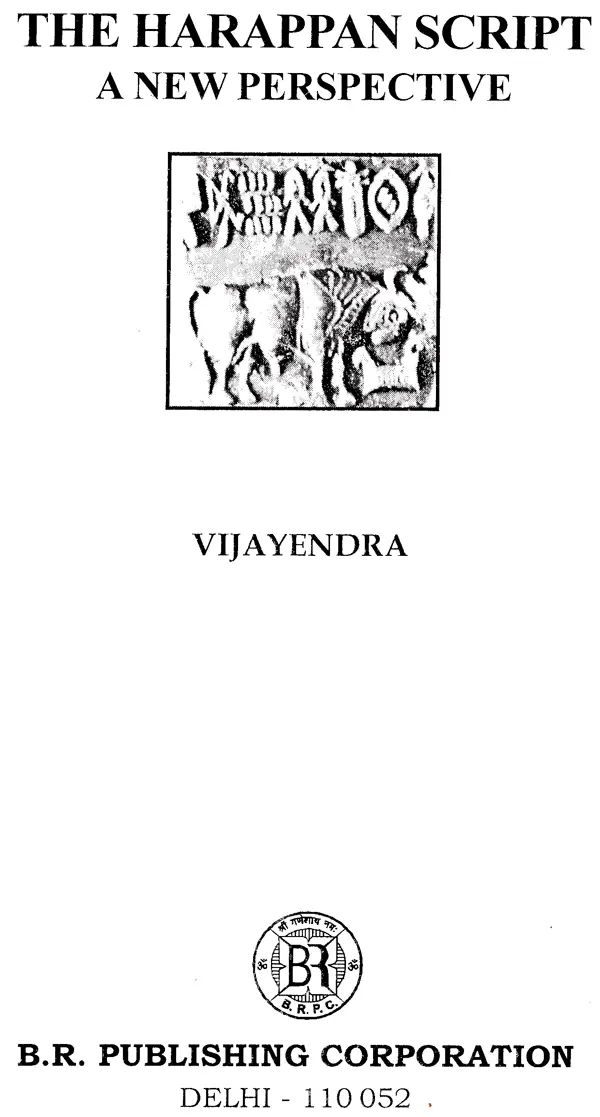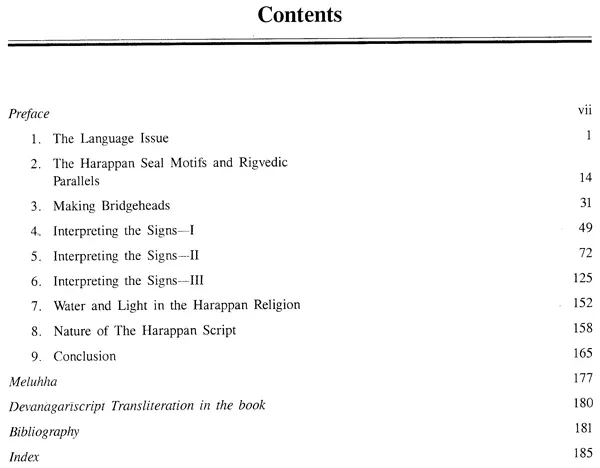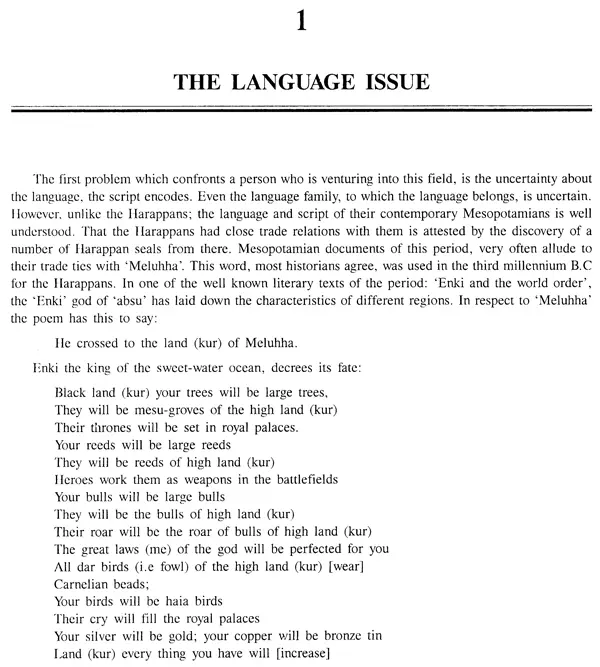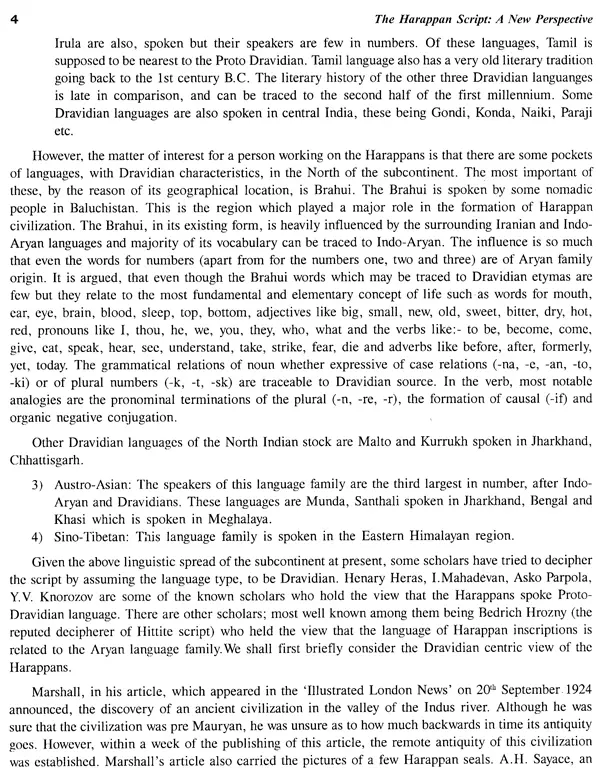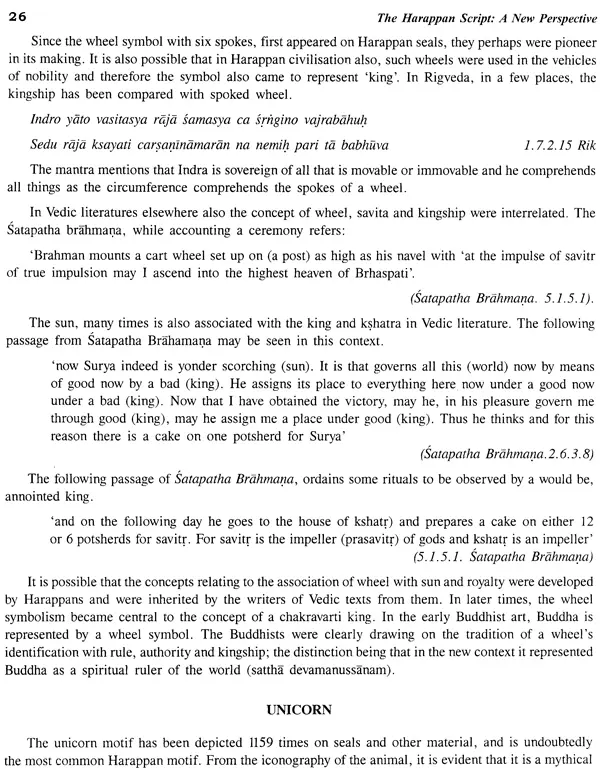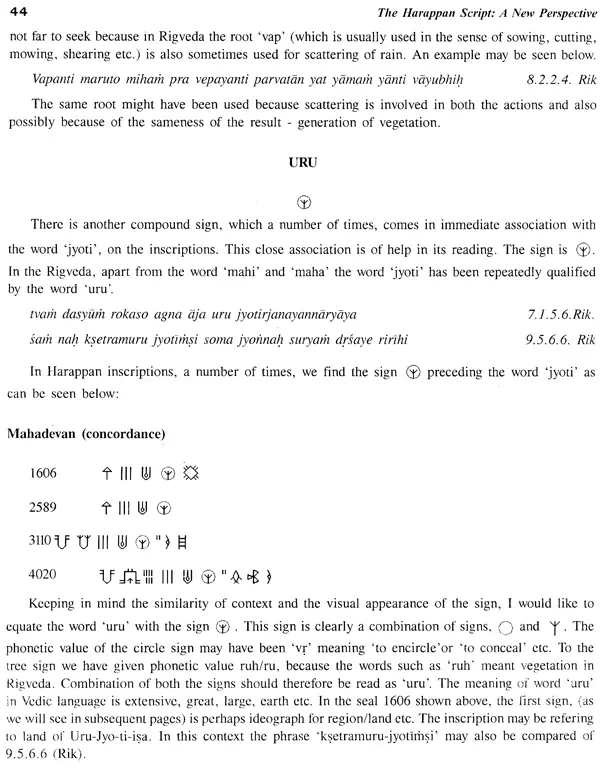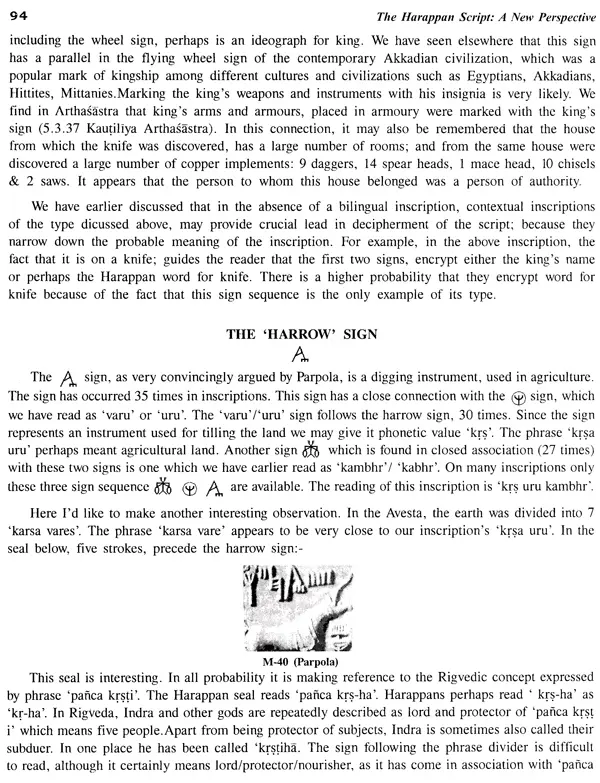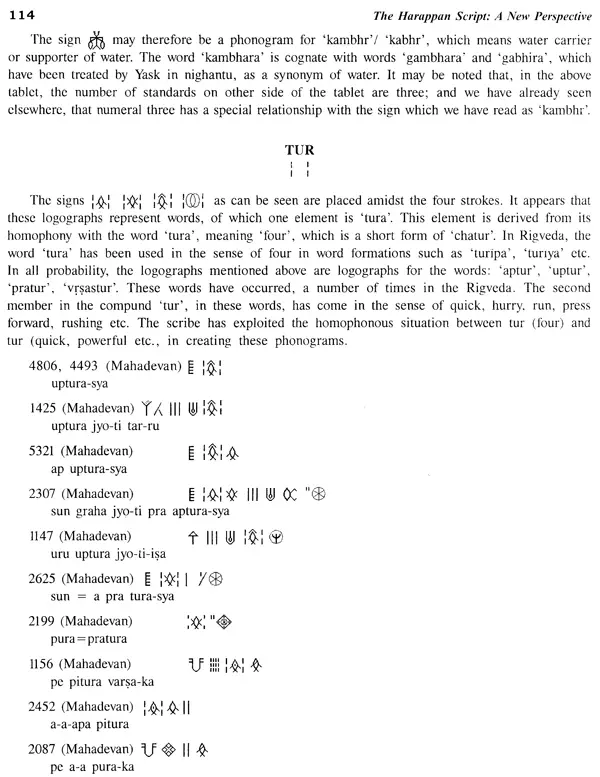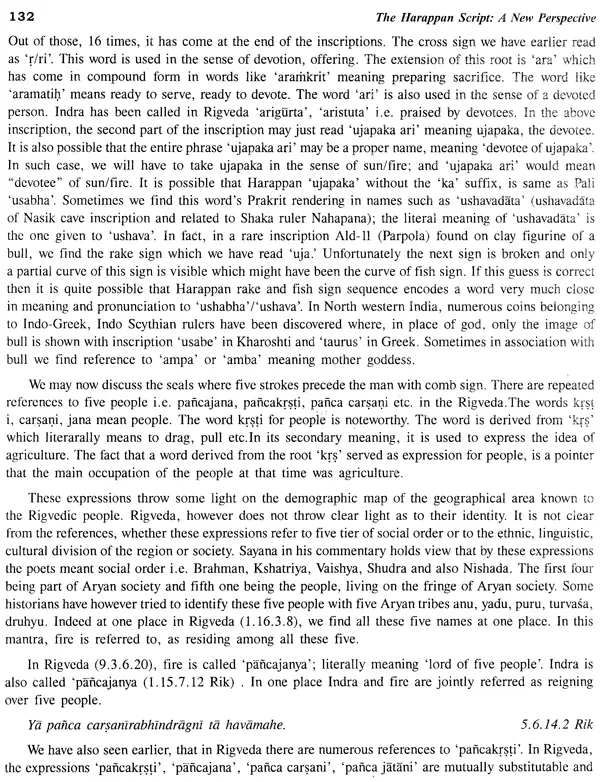
The Harappan Script - A New Perspective
Book Specification
| Item Code: | UAS278 |
| Author: | Vijayendra |
| Publisher: | B.R. Publishing Corporation |
| Language: | English |
| Edition: | 2011 |
| ISBN: | 9788176467742 |
| Pages: | 192 |
| Cover: | HARDCOVER |
| Other Details | 11.50 X 9.00 inch |
| Weight | 1.12 kg |
Book Description
Three thousand years before the birth of Christ a magnificent civilization flourished in the vast area, now constituting Pakistan and western part of India. More than one thousand Harappan sites, dotted across this wide area, have already been identified and quite a few excavated. Our knowledge of this civilization has greatly expanded since it first came into notice in 1924. However, since its script is still a mystery, we are in the dark about their identity. This book is a fresh attempt at reading the Harappan script; analyzing and reading the signs and inscriptions forming its main burden. In the absence of a bilingual inscription, the author has relied on visual bilinguals and interpretation of Harappan artistic motifs in making initial bridgehead for reading the signs and clinching the language issue. It is observed that there are surprising parallels between Harappan motifs and Rigvedic metaphors. These parallels cannot be mere coincidence. The similarities are possible, only if Harappans and Rigvedic Aryans were tapping their imageries from a shared cultural stream. The author is of the view that Aryan language is a serious contender for the Harappan script. The script is found to be logo-syllabic, with very little grammatical content. Although the language of the script appears to be an Aryan, the Harappans are not found to be synonymous with Rigvedic Aryans. For example, the Harappan inscriptions refer to 'vrtra' who was held in esteem by them. However, students of Rigveda know that there this word mainly conveyed hostile and inimical connotations. At the same time many Rigvedic political, cultural, social concepts are reflected in Harappan inscriptions. This can only be explained by the fact that the ancestors of the Rigvedic people also formed part of the Harappan social milieu. The Harappans perhaps had considerable social and cultural diversity, as has been the case in India, all through the recorded history. The book provides a fresh insight into the unresolved issue of the Harappan script.
Born at Baraut, District Baghpat, state of Uttar Pradesh in the year 1963 Shri Vijayendra is a civil servant by profession. He has a deep interest in Ancient Indian history, archaeology and literature and likes to pursue these interests in his leisure time. The enigmatic Harappan script, which is the subject matter of this book, specially fascinates him. An I.A.S. Officer of Assam cadre, he has served the Government with distinction in various capacities. Presently he is serving as Chairman, Board of Secondary Education in Chhattisgarh state.
The specimen of Harappan writing came to the notice of scholars for the first time, in the year 1872, when Sir Alexander Cunningham while conducting archacological survey in the province of Punjab, reported about a seal in the possession of Major Clark, which was discovered from Harappa. In subsequent years, more seals, clay tablets, copper tablets, potsherds, with short inscriptions (so characteristic of Harappan writing system) have come to light. Ever since the discovery of the first seal, a number of scholars, beginning with Cunningham himself have made efforts to decode the script and read the words hidden behind this enigmatic script. Despite claims by many scholars in having succeeded in reading it; the script is treated by most of the critics as undeciphered. The only aspect of the script on which the scholars are unanimous is that it was written from right to left. Another aspect on which there is a fair amount of agreement is that it belongs to Logosyllabic type i.e a script in transition from "logographic' to syllabic'. Apart from these two aspects, there is very little agreement amongst scholars. Even the most rudimentary question, the linguistic family to which the Harappan language belongs, the scholars are not able to settle with full confidence. Deciphering an unknown script that encodes an unknown language is indeed a difficult task. The enormity of the problem is further compounded by the fact that the corpus of written texts, in case of Harappans, is very limited and there is complete lack of long, written texts, which could have proved crucial in understanding the structure of the script and the language. The longest Harappan inscription (on the same side) consists of only 17 characters. Overarching all these odds is the fact that we have no bilingual inscription to help us in our task. Odds facing a person who tries to venture in this field are no doubt many; however, it must be kept in mind that in past, the script such as Linear B, facing similar odds was successfully deciphered. Contributions of Harappans to subsequent religious, social and economic institutions of the Indian sub-continent are profound. The identity of these great people, however, is still shrouded in mystery; which can only be solved if their script is deciphered satisfactorily. To solve the mystery and to reach the soul of this great civilization, the people interested in Indology, would keep making attempts to read the script, whatever may be the odds. Fortunately, for those working in this field, very good source material to work upon are now available. Shri I.Mahadevan's concordance, published in 1977, is very useful and is still unsurpassed as far as the statistical analysis of signs is concerned. Two volumes of 'Corpus of Indus seals and inscription', brought out by a Finnish team in 1987 and 1991, containing very good quality photographs of the inscriptions available in collections of India and Pakistan, provide excellent source material. In the present book, the reference numbers given to the inscriptions are either from concordance of Mahadevan or corpus of Parpola. In case of Dholavira seals, which are not yet published, the ASI register entry number have been given. I am thankful to Shri Babu Rajiv, I.A.S. D.G. A.S.I and Shri R.S. Bisht to allow me access to this unpublished material.
The evolution of ancient writing systems has become more and more clear during the last centuries with the decipherment of a number of ancient scripts. The writing, it is largely agreed an scholars, has its origin in clay tokens used for keeping the records of objects deposited/offered in temples accounted for. Initially the writing was logographic, meaning, that a sign represented a full word. In These tokens had distinctive logographs of the objects such as sheep, ewe, wool, cloth, etc. which they ancient languages, just like modern languages, there were 'homophone" words. Homophones are those words, which have same pronunciation but different meaning such as "2' and 'to" in English language there was naturally an inclination to use one sign to express such homophones instead of using differem have same pronunciation but different meaning. In such a situation, to make the writing system easier. you as 2 u", "for you as 4 u etc. The use of this principle, which is called "Rebus", pushed the signs. In present day also the SMS senders use the idea by writing the word "waiting" as "wing","t logographic writing systems towards phonetisation in the ancient times. The logographic scripts transitioned; first from logographic to "logosyllabic' and then, to full "syllabic" system. Syllabic writing system is a system where one sign or syllabogram represents one syllable, while towards phonetisation resulted in drastic reduction in the number of signs. Therefore, while the early logosyllabic is a system in which logographs as well as syllabograms, both are used. The transition script, could express speech with less than 200 signs. Purely phonetic scripts, such as ancient Greek, could manage with just 26 signs. In Harappan writing system we have approximately 450 signs, which would place it in 'logosyllabic' type of script. The decipherment of ancient scripts has resulted in understanding the principles and rules of writing systems. The ancient scribe used many devices to make the writing more effective and easy. They comprehensively used semantic and phonetic determinants. The semantic determinants are word classifiers. which were used before or after the logographs to assist the reader in the correct understanding of the word. Thus before the name of gods, semantic determinant sign was used by Sumerian scribes. It was to indicate that what follows is the name of a god. Similarly, word classifiers were used before the name of a king, city, river, country, bird etc. Two logographic or logosyllabic scripts may differ from each other in outer form but they conform to some universals (such as application of rebus) which are common to all logographic or logosyllabic scripts. It is here that the knowledge and experience gained from the study of ancient scripts may be put to use in deciphering the Harappan script.
**Contents and Sample Pages**
